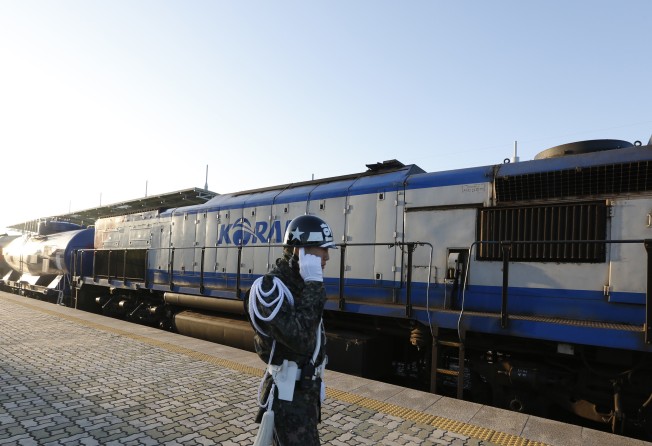
As trains cross the DMZ between the Koreas, hopes rise for an energy supergrid
- South Korean President Moon Jae-in is pushing an ambitious project to connect the Korean peninsula to Eurasia via transport and energy links

The trains that have been crossing the demilitarised zone between North and South Korea, the latest sign of rapprochement between the divided neighbours, are carrying more than just hopes for peace. Riding the track from Seoul to Pyongyang is an ambitious plan to connect the Korean peninsula to Eurasia by tying together transport and energy networks across the region.
“The trans-Eurasian railway network will transform South Korea practically from a DMZ-cut island to a Eurasian port nation, with the very best access to the Pacific for all nations in Eurasia,” said Chang Kyung-sup, an economics professor at Seoul National University.
“The economic opportunities and benefits accruing to such strategic position will be enormous.”
Officials from both sides met last week to discuss plans for a joint ceremony to begin work on the inter-Korean railway, setting December 26 as the tentative date. There is speculation that North Korean leader Kim Jong-un, who has yet to realise his promise to visit Seoul, and South Korean President Moon Jae-in could both be in attendance.
The two Koreas, however, will need approval from Washington and the UN to realise the project. It likely violates sanctions against North Korea, which has made hardly any progress on denuclearisation.
South Korea’s Unification Ministry has promoted the rail link to the international community as a symbol of peace and reconciliation.
For South Korean President Moon Jae-in, whose approval ratings slid to 48.5 per cent last week on the back of a stagnant economy and the lowest job growth in eight years, there is also an economic rationale for the project.
In a recent report, the Seoul-based Hyundai Research Institute warned that the South Korean economy could be headed for choppy waters.

“We believe that the economy reached its peak in May 2017 and has since been in a downturn phase,” the report said.
The International Monetary Fund and Asian Development Bank have both lowered South Korea’s growth expectations for next year to 2.6 per cent, down 0.2 percentage point from previous estimates.
“[Given the] economic structures of South Korea, North Korea and Russia, there could be many new economic opportunities to arise, leading to more jobs and business opportunities,” said Chang.
During a trip to Moscow in June, Moon spoke with Russian media about plans to run a natural gas pipeline from Russia to South Korea via the North. The Korean Development Institute (KDI) estimates transporting natural gas through a pipeline could be between 30 and 70 per cent cheaper for South Korea than shipping, with North Korea taking upwards of US$100 million annually in transit fees. The countries are also discussing a joint power grid that, if realised, would be the first step toward connecting the entire power supply of Northeast Asia.
China, South Korea, Japan and Russia are in talks over the feasibility of what has been coined the Northeast Asia Supergrid – a plan that would combine cheap solar energy from the Mongolian desert, hydropower from Russia, and wind energy from coastal areas to deliver reliable clean energy to the entire region.
“It’s a massive system of interconnected power supply and distribution,” said Yu Hong, a research fellow at the East Asia Institute at the National University of Singapore. “The idea gained momentum after the Fukushima nuclear disaster in 2011.”
The idea of connecting the region with one giant grid was first proposed by Masayoshi Son, CEO of Japan’s SoftBank. China views the supergrid as a way to further its Belt and Road Initiative, as well as a solution to its coal dependency, which has led to some of the worst air quality in the world. Moon is also looking to cut South Korea’s reliance on coal and nuclear energy. The two countries boosted hopes for the supergrid in May when they announced their intention to ramp up research into the initiative.
The expected cost of the plan is immense. The Renewable Energy Institute, one of the firms working to establish the grid, estimates the project will cost over US$300 billion to complete.
“This is why it’s connected with China’s Belt and Road Initiative, because China has the technology and the financial firepower to fund this kind of project, but the problem is the political trust,” said Yu.
Trust in Northeast Asia remains a major hurdle, not least among the two Koreas, which are still technically at war.

But if neighbouring countries can saddle up next to each other, the project could usher in an era of clean energy that could dramatically lower emissions, while encouraging countries to build political trust as they rely on an interconnected grid for power. Korea Electric Power Corp.’s CEO Cho Kwan-eik told reporters at the Bitgaram International Expo of Electric Power Technology last year that “the project will go beyond economics and could ease tension in the Northeast Asian region.”
For North Korea, cheap energy offers an opportunity to develop its dilapidated economy.
“Pyongyang’s power plants and grid are outdated, cold war-era facilities,” said Tai Wei Lim, a researcher at Singapore’s East Asia Institute.
Ultimately, plans to connect the Korean peninsula by rail and tie it to a Northeast Asian supergrid hinge on diplomacy with North Korea. The supergrid could go ahead without North Korea, but this would create heavy additional costs of running underwater cables from China to South Korea, according to the Korea Economic Institute of America.
A recent trip to Seoul by US Special Representative Stephen Biegun has spurred hopes for a thaw in the US-North Korea stalemate, with the possibility of resuming humanitarian aid to North Korea on the table as a means to inject new momentum into sluggish talks.